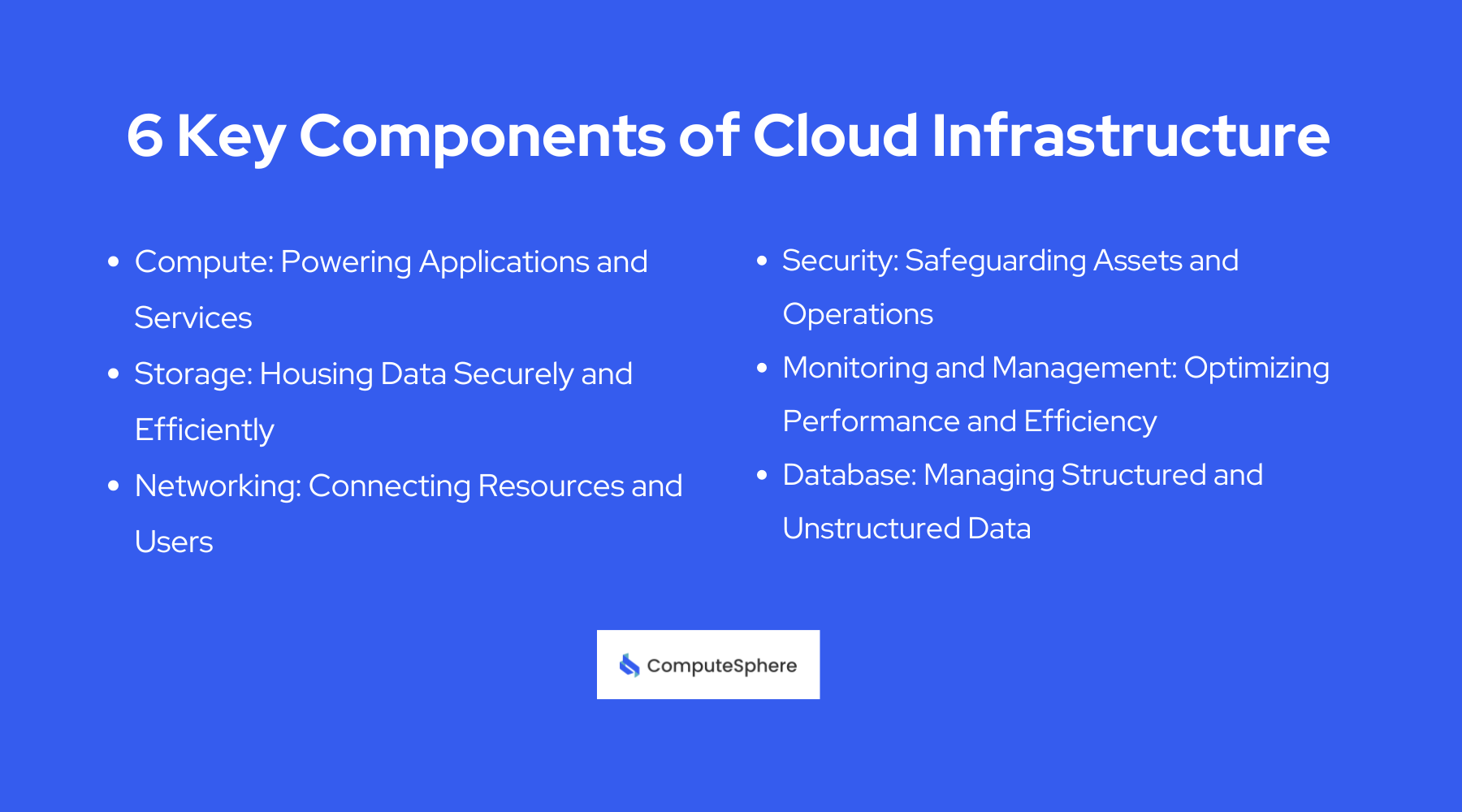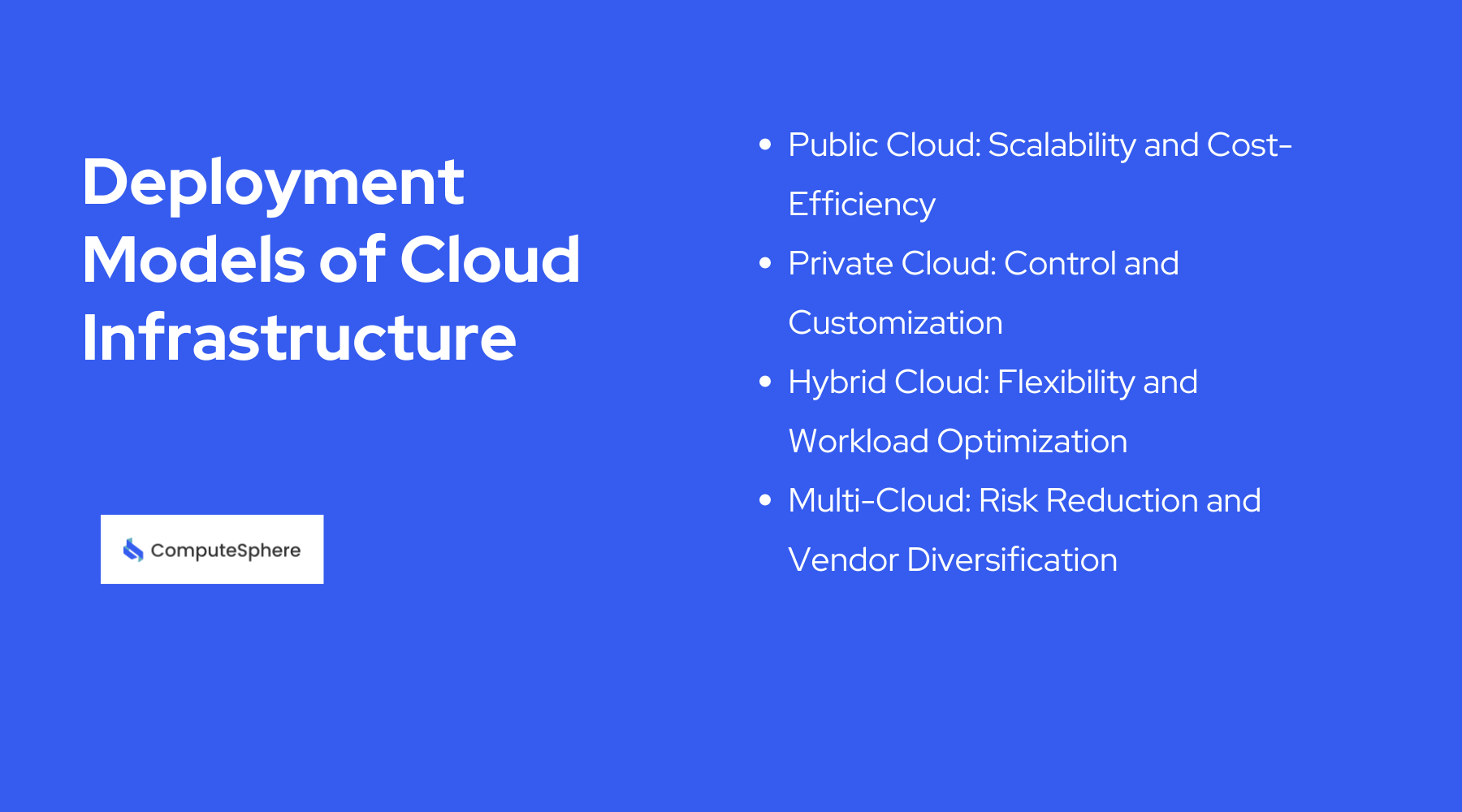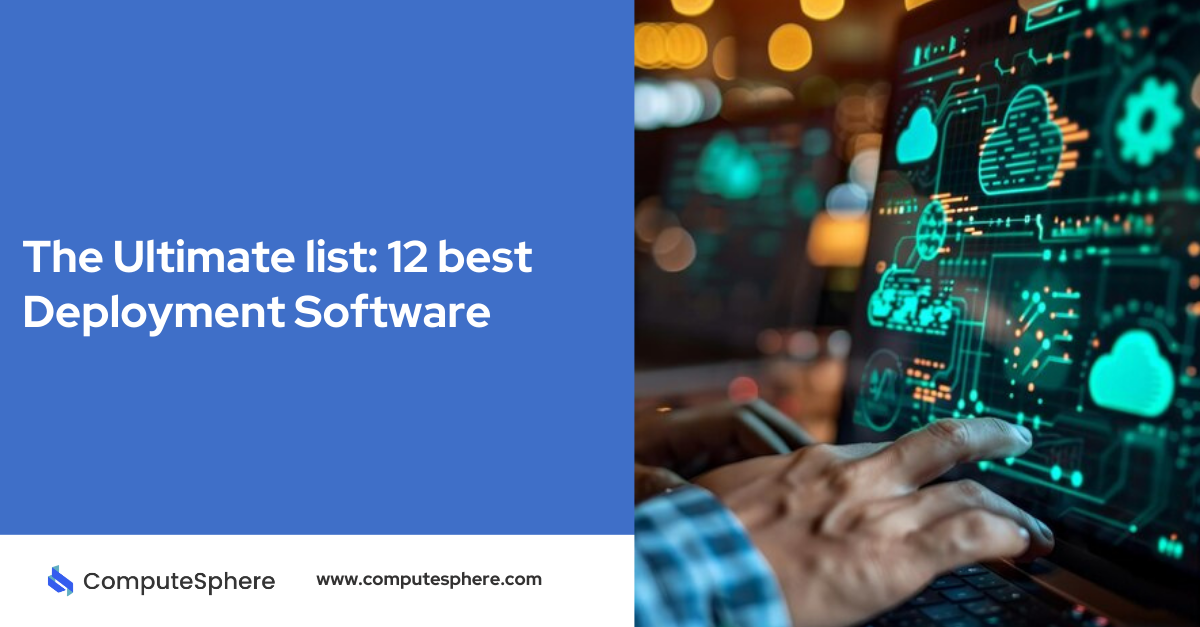Cloud Infrastructure: 6 Key Components and Deployment Models

Cloud infrastructure represents the foundational framework of computing resources, storage capabilities, networking solutions, and management tools. This infrastructure enables organizations to move beyond physical hardware limitations and adopt a more agile, cost-effective approach to IT operations. Through cloud computing, businesses can dynamically scale resources up or down based on demand, deploy applications globally with ease, and innovate rapidly without significant initial investments.
Let's explore the key elements of cloud infrastructure and understand how different models suit various organizational requirements.
6 Key Components of Cloud Infrastructure

Compute: Powering Applications and Services
At the core of cloud infrastructure lies compute power, which forms the computational backbone for running applications and processing data. Virtual Machines (VMs) simulate physical computers and enable organizations to run multiple operating systems and applications on a single physical server. This virtualization technology supports the flexibility and scalability of cloud computing, allowing for efficient resource allocation and utilization.
The Docker containers offer a lightweight alternative to VMs by packaging applications and their dependencies into portable, isolated environments. This approach promotes consistency across development, testing, and deployment stages, encouraging agility and accelerating time-to-market for new software releases.
The evolution towards event-driven architectures is represented by serverless computing, where cloud providers manage the infrastructure. This allows developers to focus solely on writing code that responds to events and triggers. Services like AWS Lambda exemplify this change, offering scalability and cost-efficiency by charging based on actual usage rather than pre-allocated capacity.
Storage: Housing Data Securely and Efficiently
Effective data management lies at the heart of cloud infrastructure. It facilitates diverse storage solutions designed to meet varying needs. The Amazon S3 provides scalable, durable repositories for unstructured data ideal for storing multimedia content, backups, and archives. This approach ensures high availability and reliability while enabling seamless access from anywhere in the world.
Moreover, solutions like AWS Elastic Block Store (EBS) serve applications requiring long-term storage volumes that can be attached to VM instances. These volumes deliver fast performance and support crucial functionalities like database hosting and transaction processing in cloud environments.
The Network File System (NFS) offers shared access to files across multiple computing nodes, facilitating collaborative workflows and centralized data management. Cloud-based file systems enhance flexibility and streamline data accessibility for distributed teams by abstracting storage from physical hardware.
Networking: Connecting Resources and Users
Cloud networking encompasses a suite of services designed to interconnect resources within virtual environments and extend connectivity to end-users across the globe. Virtual Private Clouds (VPCs) establish isolated networks within the cloud, allowing organizations to define custom IP address ranges, configure route tables, and enforce network security policies. This isolation enhances data privacy and minimizes exposure to potential threats, aligning with organizational security standards.
In addition, to load balancers optimizing resource utilization and ensuring high availability, cloud networking also includes DNS (Domain Name System) services that translate domain names into IP addresses, facilitating seamless communication across the internet. DNS resolution plays a critical role in routing users to the nearest server, thereby reducing response times and improving the overall responsiveness of web applications.
Moreover, cloud networking involves VPN (Virtual Private Network) services that enable secure remote access to corporate networks from anywhere. By encrypting data transmitted over public networks, VPNs ensure confidentiality and integrity of communications, supporting remote workforces and enabling secure connectivity for distributed teams. These components collectively form the backbone of cloud networking, enabling organizations to build scalable, resilient, and secure IT infrastructures that support global operations and enhance user experiences.
Security: Safeguarding Assets and Operations
Security remains very important in cloud infrastructure. Data integrity, confidentiality, and availability are critical considerations for organizations entrusting sensitive information to third-party providers. Identity and Access Management (IAM) frameworks regulate user permissions and privileges. It ensures that only authorized individuals and systems can access resources and perform specific actions within the cloud environment. Organizations bolster their defense against unauthorized access attempts and potential insider threats through the implementation of least privilege principles and multifactor authentication mechanisms.
Network security measures, including firewalls and Virtual Private Networks (VPNs), establish perimeter defenses and secure communication channels between cloud-based applications, users, and external networks. These safeguards shield sensitive data from harmful actors and reduce risks associated with unauthorized network intrusions and data breaches.
Moreover, encryption technologies play an important role in safeguarding data both at rest and in transit within cloud environments. Organizations ensure the confidentiality and integrity of data by using strong algorithms and cryptographic keys, maintaining security even if intercepted or accessed by unauthorized parties. Cloud providers offer managed encryption services, simplifying key management and compliance with data protection regulations across global regions.
Monitoring and Management: Optimizing Performance and Efficiency
Effective monitoring and management tools are essential for monitoring cloud infrastructure performance, optimizing resource utilization, and proactively addressing operational challenges. Cloud-native monitoring services, such as Amazon CloudWatch and Google Cloud Monitoring, provide real-time insights into system metrics, application performance, and resource utilization across virtualized environments. These tools enable IT teams to detect anomalies, troubleshoot issues promptly, and maintain service availability and reliability.
Resource management tools, such as AWS CloudFormation and Azure Resource Manager, facilitate infrastructure as code (IaC) practices by automating the provisioning and configuration of cloud resources through declarative templates. This approach improves the consistency, repeatability, and scalability of deployments while minimizing human errors and accelerating time-to-deployment for new infrastructure components and applications.
In addition, logging and auditing mechanisms capture detailed records of user activities, system events, and configuration changes within the cloud environment. Maintaining comprehensive audit trails and generating actionable insights from log data helps organizations improve visibility, compliance, and governance, supporting regulatory requirements and internal security policies.
Database: Managing Structured and Unstructured Data
Cloud databases provide scalable and high-performance solutions for storing, managing, and accessing structured and unstructured data in the cloud. Relational databases like MySQL and PostgreSQL are ideal for applications needing ACID compliance and complex queries. Managed services such as Amazon RDS and Azure SQL Database simplify database administration by handling tasks like backup, replication, and scaling.
On the other hand, NoSQL databases like MongoDB and Apache Cassandra are suited for applications requiring flexible schema designs, horizontal scalability, and distributed data models. These databases excel in managing large volumes of semi-structured and unstructured data, supporting use cases such as real-time analytics, content management, and IoT data processing in cloud environments.
Deployment Models of Cloud Infrastructure

Cloud infrastructure supports diverse deployment models designed for organizational requirements, ranging from public and private clouds to hybrid and multi-cloud architectures. Each model offers various advantages in terms of scalability, security, and operational flexibility, addressing unique business needs and regulatory considerations.
Public Cloud: Scalability and Cost-Efficiency
Public clouds—such as Amazon Web Services (AWS), Microsoft Azure, and Google Cloud Platform (GCP)—deliver computing resources and services over the internet on a pay-as-you-go basis. Organizations change public cloud infrastructure to scale resources dynamically, accelerate innovation cycles, and optimize IT spending by eliminating advanced hardware investments and operational overhead.
Public clouds offer a vast array of services, including compute instances, storage solutions, and AI (Artificial Intelligence) tools, accessible through intuitive management consoles and APIs (Application Programming Interfaces).
Private Cloud: Control and Customization
Private clouds operate within dedicated, isolated environments managed either internally by organizations or hosted by third-party providers offering exclusive infrastructure and resources. Private cloud deployments support enterprises needing enhanced control over data governance, regulatory compliance, and security protocols, while also benefiting from cloud-like scalability and operational efficiencies
The organizations retain dedicated hardware and network resources to customize infrastructure configurations, implement stringent access controls, and support mission-critical workloads with predictable performance and availability.
Hybrid Cloud: Flexibility and Workload Optimization
Hybrid clouds integrate public and private cloud environments, enabling organizations to manage workloads seamlessly across on-premises infrastructure and external cloud platforms. This deployment model allows enterprises to utilize the scalability and cost-efficiency of public clouds for non-sensitive workloads and applications that require bursts of resources while keeping sensitive data and critical workloads within secure, compliant private cloud environments.
Hybrid cloud architectures support workload portability, disaster recovery strategies, and regulatory compliance initiatives. It offers flexibility to adapt infrastructure configurations based on evolving business requirements and market dynamics.
Multi-Cloud: Risk Reduction and Vendor Diversification
Multi-cloud strategies involve employing multiple cloud providers to distribute workloads across different geographic regions, reduce dependency on any single provider, and mitigate risks associated with potential service failures or outages. Organizations adopt multi-cloud architectures to improve performance, increase resilience, and negotiate favorable pricing and service-level agreements (SLAs) across various cloud ecosystems.
Businesses gain strategic benefits in terms of innovation, cost control, and operational adaptability by changing top-tier services from multiple providers. It ensures consistent service delivery and user satisfaction in an interconnected global marketplace.
Conclusion
In summary, understanding the components and deployment models of cloud infrastructure is essential for businesses aiming to maximize their full potential. From computing and storage to security and deployment strategies like public, private, hybrid, and multi-cloud, each aspect plays a crucial role in improving operational efficiency and enabling scalability. Adopting cloud-native technologies will continue to drive innovation and flexibility, ensuring organizations remain agile and competitive in an increasingly digital world. By strategically adopting and optimizing cloud infrastructure, businesses can not only tackle current challenges but also establish the foundation for future growth and success.
Contents
Built for Builders. Priced for Startups.
Tired of unpredictable cloud bills? ComputeSphere offers modular, fixed-cost cloud hosting that grows with your startup—no DevOps headaches, no surprises.
Get StartedShare this article
Browse Some Related Blogs
Relevant and related contents you can read









